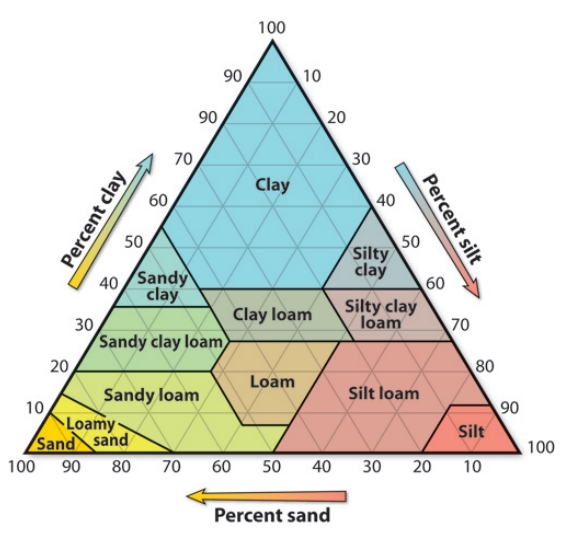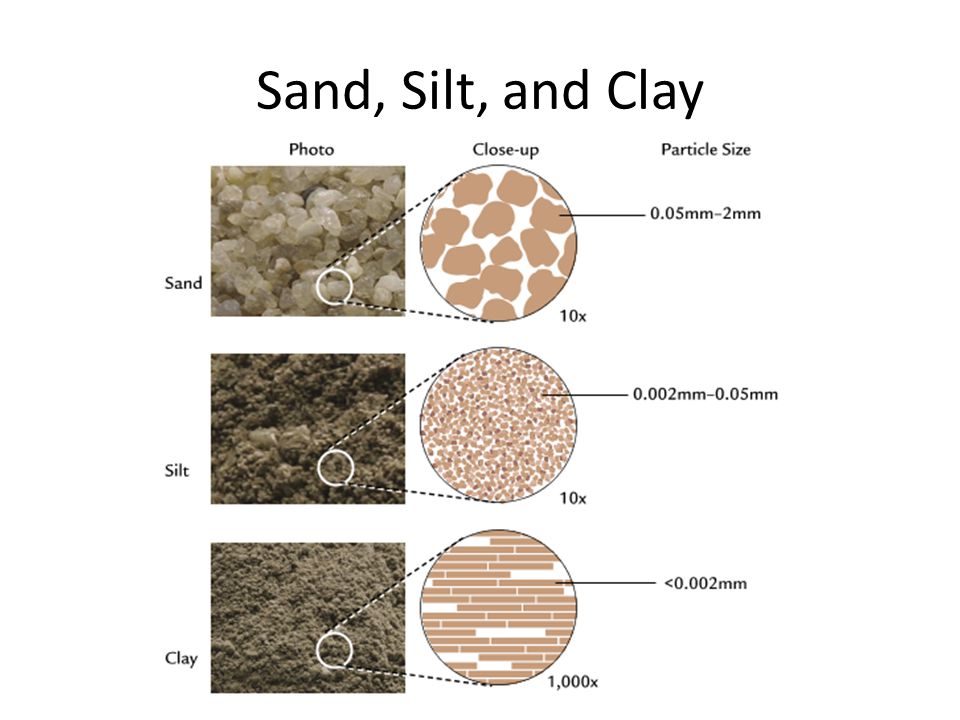Types of soil – Soils come in many textures, colours, mineral and organic compositions, and more. Find out more on sandy soils, loamy solis, chalky soils, peaty soils, clay and silty soils here.
Soil can be categorized into sand, clay, silt, peat, chalk and loam types of soil based on the dominating size of the particles within a soil.
Soil is a natural resource that can be categorised into different soil types, each with distinct characteristics that provide growing benefits and limitations.
Identifying the type of soil you require for a project is paramount to support the healthy growth of plant life.
Soil can be categorised into sand, clay, silt, peat, chalk and loam types of soil based on the dominating size of the particles within a soil.
In this article we will also learn, What determine the type of soil ?
Types of Soil
Just like plants and people, soils have different characteristics that make them unique. Knowing the kind of soil you have helps you determine its strengths and weaknesses. While soil is composed of many elements, the place to begin is with your soil type. You just have to observe the composition of the soil’s particles.
You can use following image to draw the line diagram to identify types of soils.

The soil is basically classified into four types:
- Sandy soil.
- Silt Soil.
- Clay Soil.
- Loamy Soil.
Sandy soil
Sandy Soil is light, warm, dry and tend to be acidic and low in nutrients. Sandy soils are often known as light soils due to their high proportion of sand and little clay (clay weighs more than sand).
These soils have quick water drainage and are easy to work with. They are quicker to warm up in spring than clay soils but tend to dry out in summer and suffer from low nutrients that are washed away by rain.
The addition of organic matter can help give plants an additional boost of nutrients by improving the nutrient and water holding capacity of the soil.
Sandy soil consists of small particles of weathered rock. Sandy soils are one of the poorest types of soil for growing plants because it has very low nutrients and poor in holding water, which makes it hard for the plant’s roots to absorb water. This type of soil is very good for the drainage system. Sandy soil is usually formed by the breakdown or fragmentation of rocks like granite, limestone, and quartz.
Clay Soil
Clay Soil is a heavy soil type that benefits from high nutrients. Clay soils remain wet and cold in winter and dry out in summer.
These soils are made of over 25 percent clay, and because of the spaces found between clay particles, clay soils hold a high amount of water.
Because these soils drain slowly and take longer to warm up in summer, combined with drying out and cracking in summer, they can often test gardeners.
Clay is the smallest particles amongst the other two types of soil. The particles in this soil are tightly packed together with each other with very little or no airspace. This soil has very good water storage qualities and making hard for moisture and air to penetrate into it. It is very sticky to the touch when wet, but smooth when dried. Clay is the densest and heaviest type of soil which do not drain well or provide space for plant roots to flourish.
Silt Soil
Silt Soil is a light and moisture retentive soil type with a high fertility rating.
As silt soils compromise of medium sized particles they are well drained and hold moisture well.
As the particles are fine, they can be easily compacted and are prone to washing away with rain.
By adding organic matter, the silt particles can be bound into more stable clumps.
Silt, which is known to have much smaller particles compared to the sandy soil and is made up of rock and other mineral particles which are smaller than sand and larger than clay. It is the smooth and quite fine quality of the soil that holds water better than sand. Silt is easily transported by moving currents and it is mainly found near the river, lake, and other water bodies. The silt soil is more fertile compared to the other three types of soil. Therefore it is also used in agricultural practices to improve soil fertility.
Peat Soil
Peat soil is high in organic matter and retains a large amount of moisture.
This type of soil is very rarely found in a garden and often imported into a garden to provide an optimum soil base for planting.
Peaty soils are acidic and as a result, does not support decomposition very well. It is dark in color, rich in organic material, although contains less nutrients than loamy soils. It retains water very well.
Chalk Soil
Chalk soil can be either light or heavy but always highly alkaline due to the calcium carbonate or lime within its structure.
As these soils are alkaline they will not support the growth of ericaceous plants that require acidic soils to grow.
If a chalky soil shows signs of visible white lumps then they can’t be acidified and gardeners should be resigned to only choose plants that prefer an alkaline soil.
Chalky soils are alkaline with a pH of about 7.5. It is not acidic and often stony with chalk or limestone bedrock. It is free draining because of its coarse and stony nature. Not the best for crops to grow in as they lack manganese and iron.
Loam Soil
Loam soil is a mixture of sand, silt and clay that are combined to avoid the negative effects of each type.
These soils are fertile, easy to work with and provide good drainage. Depending on their predominant composition they can be either sandy or clay loam.
As the soils are a perfect balance of soil particles, they are considered to be a gardeners best friend, but still benefit from topping up with additional organic matter.
The ideal soil is 40 percent sand, 40 percent silt, and 20 percent clay. You’ll hear this mixture referred to as loam. It takes the best from each soil particle type. It has good water drainage and allows air to infiltrate the soil like sand, but it also holds moisture well and is fertile like silt and clay.
|
Soil Texture
| Intake Rate | Field Capacity | |
| inch | milimeters | % percent | |
| Clay | 0.1 | 2.54 | 0.357 |
| Silty Clay | 0.15 | 3.81 | 0.3485 |
| Sandy Clay | 0.25 | 6.35 | 0.306 |
| Clay Loam | 0.2 | 5.08 | 0.306 |
| Silty Clay Loam | 0.15 | 3.81 | 0.2365 |
| Sandy Clay Loam | 0.25 | 6.35 | 0.306 |
| Loam | 0.35 | 8.89 | 0.26 |
| Silt Loam | 0.32 | 8.128 | 0.272 |
| Silt | 0.3 | 7.62 | 0.255 |
| Sandy Loam | 0.4 | 10.16 | 0.17 |
| Loamy Sand | 0.5 | 12.7 | 0.14 |
| Sand | 0.6 | 15.24 | 0.1 |
Types of Soils Based on Grain Size
- Cobbles : These are larger than pebbles and smaller than boulders. The size is between 64 to 256mm.
- Gravels: The diameter is between 4.75 and 76.2mm
- Clay: Soil grains finer than 0.002mm
- Silt: Soil grain with size ranging from 0.075 to 0.002mm
- Sand: Particles seen by naked eye and size less than 4.75mm
Different Transported Soils and their Transporting Agent
| Sl. No | Soil Type | Transporting Agent | Properties |
| 1 | Alluvial Soil | Running Water | Coarser and Finer Particles |
| 2 | Lacustrine Soil | Water – Deposited at quiet lakes | Coarser and Finer Particles |
| 3 | Marine Soils | Sea water | Coarser and Finer Particles |
| 4 | Aeolian Soils | Wind | Silt – low density and high compressibility |
| 5 | Colluvial Soils | Gravitational Force | |
| 6 | Glacial Soil | Glaciers | Finer Particles, boulders |
The soils formed at a place may be transported to other places by agents of transportation, such as water, ice, wind and gravity.
Organic Soils & Inorganic Soils: The soils that have organic origin comes under the category of organic soils. These are formed by the growth and decomposition of the plants, shells of organisms, inorganic skeletons etc. Sometimes inorganic content by some source can make the soil inorganic.
Different Soils Used in Practice
- Bentonite : The clay formed by the decomposition of volcanic ash. Properties of clay are exhibited highly. This contain high amount of montmorillonite.
- Kaolin: This is also called as china clay which is pure form of white clay. The main application are in clay industries
- Boulder Clay: This is acombination of sedimented deposited clay (glacial clay) with unsorted rocks and pulverised clay.
- Varved Clays: Consist of layers of silt and flat clays.
- Shale : This material have a state between clay and slate
- Marl : This material is a combination of clay, loam and calcareous sands
- Peat : Fibrous aggregate with decomposed fragments of vegetable matter. Very compressible in nature and used for supporting of structures.
- Loam : This material is a combination of silt, clay and sand
Further reading about soil types

*****